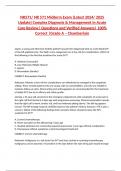NR571/ NR 571 Midterm Exam (Latest 2024/ 2025
Update) Complex Diagnosis & Management in Acute
Care Review| Questions and Verified Answers| 100%
Correct |Grade A – Chamberlain
Jasper, a young and otherwise healthy patient has just been diagnosed with an acute distal DVT
of the left popliteal vein. The Well's score categorizes her at low risk for complications. Which of
the following is the first-line treatment for acute DVT?
A. Warfarin (Coumadin)
B. Low Molecular Weight Heparin
C. Aspirin
D. Rivaroxaban (Xarelto)
CORRECT: Rivaroxaban (Xarelto)
Rationale: Patients at low risk for complications can effectively be managed in the outpatient
setting. These include patients who are young, with no comorbidities, and who are reliable to
maintain follow-up visits. Direct-acting oral anticoagulants are recommended for the treatment
of stable DVT, due to its efficacy and safety profile.
Jacinda, a 52-year-old, presents to the emergency department with complaints of acute pain in
the right calf that started 4-5 days ago with progressive worsening. Physical examination reveals
that the right calf is warm, tender, red, and has moderate pitting edema. The left leg appears
normal. The NP strongly suspects cellulitis based on the patient's history, however, VTE is also a
concern. Which of the following findings from Jacinda's history should increase the NP's
suspicion for DVT?
A. Current chemotherapy
B. Minor laceration to the affected leg 7 days ago
C. Hospital admission for community-acquired pneumonia 1 year ago without complication
D. Menopause without symptoms or pharmacological treatment
CORRECT: Current chemotherapy
Rationale: Malignancy is a risk factor for DVT and since Jacinda is receiving chemotherapy,
malignancy can be assumed. A laceration in the days before the start of leg pain would strongly
,support cellulitis. Previous admission for pneumonia without complication does not increase a
person's risk for VTE. While hormone replacement should raise the NP's suspicion for VTE, there
is no indication that the patient is being treated with HRT for asymptomatic menopause.
Eleanor, a 39-year-old, presents to the emergency department for severe pain and swelling in
her left calf that began yesterday. Significant history includes the following: a 20-pack-year
smoking; breast cancer (completed chemotherapy 4 months ago); and travel from Europe (8-
hour flight) within days before pain onset. She takes no medications, has no known medication
allergies, and no previous VTE history. She denies fever, chest pain, and shortness of breath.
Physical exam reveals severe, unilateral left lower extremity swelling (8 cm greater than the
non-affected side) with pitting edema, and exquisite localized tenderness along the popliteal
region. Vital signs are within normal limits. Which of the following is the appropriate next step?
A. Start warfarin (Coumadin) and adjust to target INR of 2.0-3.0
B. Order a left lower extremity compression ultrasound
C. Obtain a ventilation-perfusion scan (V/Q)
D. Administer enoxaparin (Lovenox)
CORRECT: Administer enoxaparin (Lovenox)
Rationale: Since the likelihood of DVT increases in patients with multiple risk factors, the Wells
DVT score should be used to evaluate patients with suspected 1st-time acute DVT. The tool
stratifies patients according to pretest probability (0=low, 1-2=moderate, > 3=high) for clot and
is helpful when used in combination with other diagnostic tests in clinical decision-making.
Eleanor's history, symptoms, and exam findings are consistent with DVT and probability is high
(>3 risk factors). Suspicion is low for PE because she has no respiratory symptoms, therefore,
V/Q scanning is not necessary at this time.
Since the patient's history and clinical findings are consistent with DVT, and Wells score shows
high probability, treatment should be initiated before diagnostic testing is performed, unless
contraindicated. Direct-acting anticoagulation is the 1st line treatment but is not an option in
this scenario. Warfarin can be used but takes 5-7 days to reach a therapeutic level and must be
administered with LMWH until the goal is reached.
Differential Dx for VTE
include but are not limited to :
cellulitis
injury
baker's cyst
superficial thrombophlebitis.
, what are the 3 categories according to pathophysiological states for VTE risk factors
hypercoagulability, vascular damage, and venous stasis.
What are the risk factors for VTE in hypercoagulability?
Hereditary & non-hereditary coagulopathies
Autoimmune disorders (SLE, RA, hyperthyroidism, IBD, etc.)
Estrogen (OCPs, HRT, etc.)
What are the risk factors for VTE in vascular damage?
Smoking
Atherosclerotic plaque
Prolonged elevated BP
Femoral line catheterization
Surgery
What are the risk factors for VTE in venous stasis?
Prolonged immobility or hospitalization
Obesity
Paralysis of lower extremities
Pregnancy & until 12 wks. postpartum
Malignancy & chemotherapy
Clinical presentation of DVT
unilateral pain, swelling, or redness to the affected extremity
may exhibit warmth, erythema, edema, and tenderness in the affected extremity
what is the recommended treatment for stable DVT in the outpatient setting?
Direct Acting oral anticoagulants
minimum of 3 months
d/t efficacy and safety profile.
no routine laboratory monitoring is needed.
*contraindicated*
in patients with hepatic or renal impairment (CrCl <30mL/min)
No reversal agents for these
What is the first step in treating acute VTE?
preventing further thrombus by starting a med that rapidly inhibits thrombin




